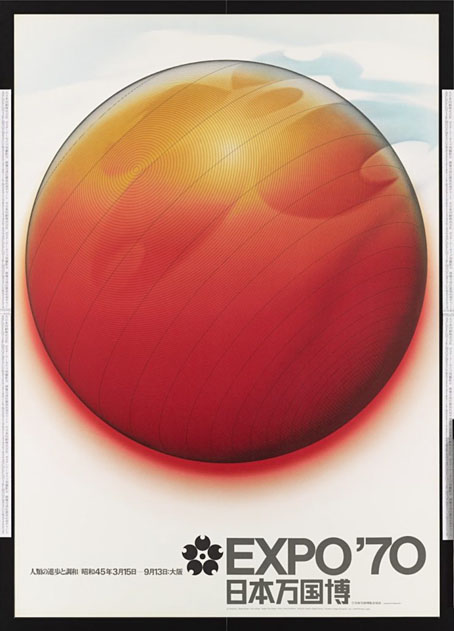
Poster design by Eiko Ishioka.
After writing about Expo 2000 I went looking for films of some of the other world expositions. In previous posts I’d managed to exhaust the Paris Exposition Universelle of 1900 as a subject but never really followed up on my intention to explore the 20th-century events. The 1900 exposition was the first for which a quantity of film footage exists; it was also the one where motion pictures were presented as a new invention among others, like electric light, that would dominate the coming century. The ephemerality of these big events is part of their fascination, and a reason to look for films that document them. Expositions are like temporary theme parks, where the emphasis, since 1939 at least, has tended towards the way things might look in the future. Architects and designers aren’t exactly given free reign at an exposition but they’re also not having to tailor their designs to the requirements of urban planning committees. The events provide a concentrated dose of futurity for a short time in a small geographical space. It ought to be noted that “world exposition” has a specific meaning (see this list), referring to large, general events which run for six months or more. Smaller expositions devoted to single subjects also exist, although “small” here is relative, these can still be sizeable affairs.
Most of the footage that follows is from American expositions. Americans seem to prefer the term “World’s Fair”, although not exclusively—there was a Brussels World’s Fair—and not consistently: the Seattle event in 1962 was the Century 21 Exposition. There’s a lot more footage out there, of course, but I was looking for official films and documentaries rather than home movies.
The New York World’s Fair, 1939
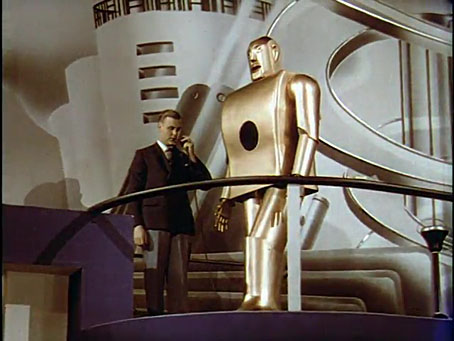
• The Middleton Family at the New York World’s Fair
This drama illustrates the contribution of free enterprise, technology, and Westinghouse products to the American way of life. The Middleton Family at the New York World’s Fair pits an anti-capitalist bohemian artist boyfriend against an all-American electrical engineer who believes in improving society by working through corporations. The Middletons experience Westinghouse’s technological marvels at the Fair and win back their daughter from her leftist boyfriend.
Memorable moments: the dishwashing contest between Mrs. Modern and Mrs. Drudge; Electro, the smoking robot; and the Westinghouse time capsule.
Too much drama in this one, and not enough expo, but the 1939 world’s fair is where the preoccupation with the future begins. The Middletons were a promotional device, also seen in newspaper and magazine ads. This is the world’s fair that gave us the word “Futurama”. A shame, then, that Electro, the cigarette-smoking robot, doesn’t tell the All-American Family to bite his shiny metal ass.
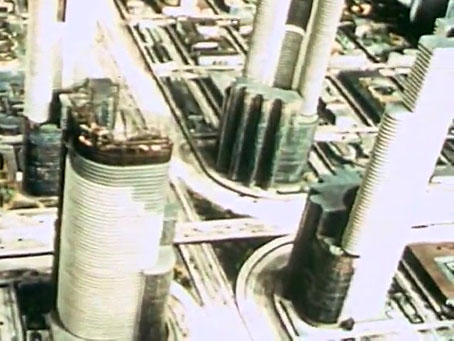
• To New Horizons
The Hugh Ferriss view of the future (sponsored by General Motors), all skyscrapers and superhighways. Pedestrians? What are they?
The Brussels World’s Fair, 1958
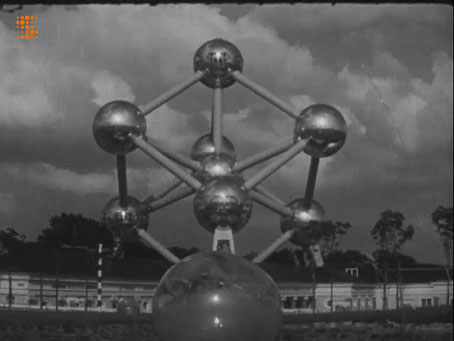
• L’Expo 58, il y a un an
A retrospective view of the Brussels event in murky monochrome. The Czech film below is better value although the second half is mostly concerned with the Czech pavilion.
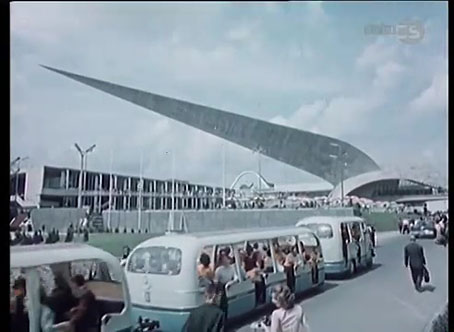
• Ceskoslovensky pavilon – Expo 58
The Century 21 Exposition, 1962
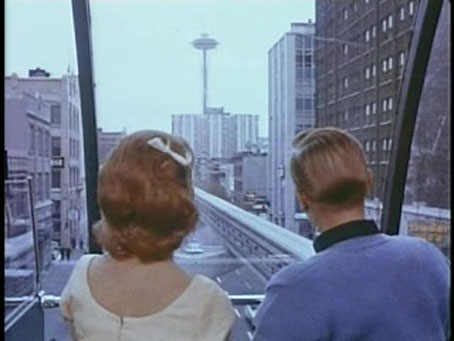
• Century 21 Calling
A trip to the Seattle exposition in which our guides are a hyperactive teen couple who look like the squares from Hairspray after they’ve been dosed with bop pills. For a generation of Brits “Century 21” will always mean Gerry Anderson’s Space-Age imagination.
The New York World’s Fair, 1964
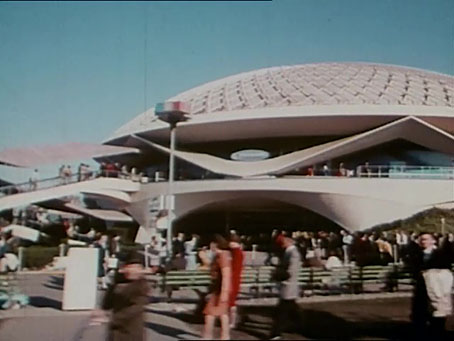
• To the Fair!
A 25-minute documentary, directed by Alexander Hammid and Wheaton Galentine, with more confected drama as two young men pursue a pair of attractive women through the exhibits.
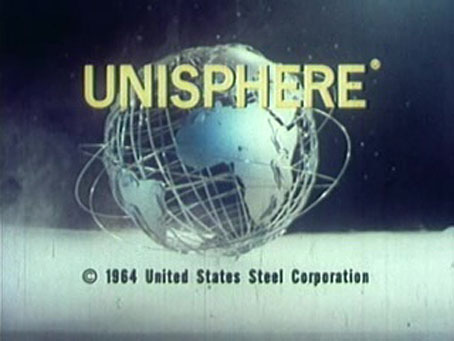
• Unisphere: Biggest World on Earth
A film by the United States Steel Corporation showing the construction of the Unisphere, “the largest globe in the world”, for which they provided the raw material. This one includes footage from earlier world expos but neglects to mention that the Exposition Universelle had a very large globe of its own. The Unisphere was one of the few surviving features from the 1964 expo until its destruction in 1997 by an alien trying to flee the Earth in a flying saucer.
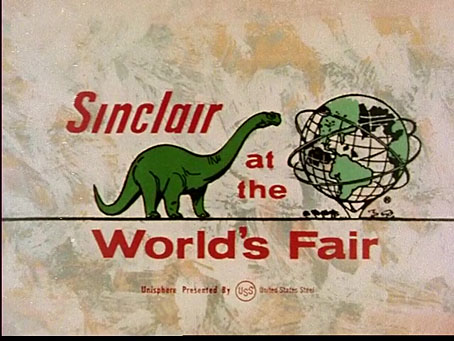
• Sinclair at the World’s Fair
The fair seen through the eyes of Sinclair Petroleum and their dinosaur-brand gas station.
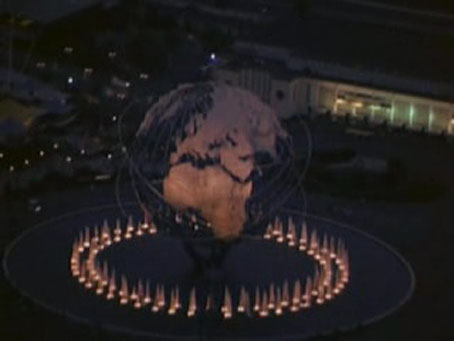
• World’s Fair Night Aerials
Raw aerial footage of the fair at night.
Expo 67, Montreal
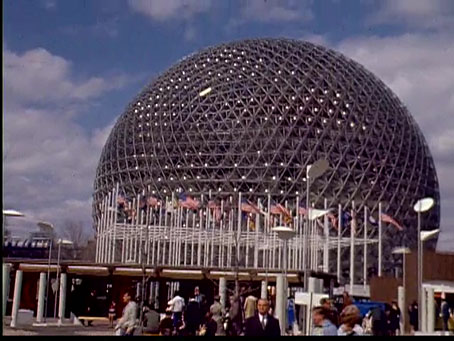
• Expo 67
The Montreal Exposition filmed by Henry Charles Fleischer. All shaky hand-held shots but high-quality footage. Ten years later, Robert Altman used the run-down remains of some of these buildings for Quintet, a science-fiction film about a futuristic ruin filled with the survivors of a new ice age.
Expo 70, Osaka
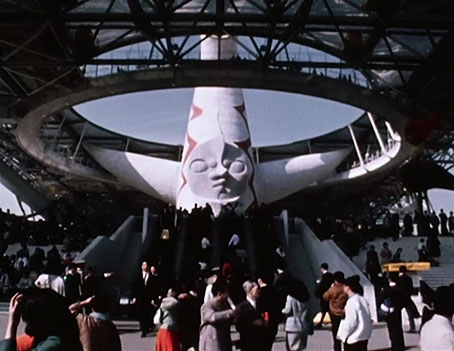
• Expo 70 d’Osaka au Japon
A 50-minute Canadian documentary (with French narration) about the Japanese event. The Osaka exposition has more cult value than most. Justin Wright has been performing his own brand of kosmische musik as Expo ’70 for several years, while this film is one of many posted at a YouTube channel devoted to different aspects of the exposition.
Previously on { feuilleton }
• The exposition moiré
• Angkor in Paris, 1931
• The world of the future
• Space Needle USA
• A Trip to the Moon, 1901
• Le Panorama Exposition Universelle
• Exposition cornucopia
• The Evanescent City

I went to 2 World’s Fairs–the 2nd was Expo 67 (a few years after ’67) which had a pavilion entitled
“Le Monde Insolite/It’s A Strange, Strange World” which had
ORIGINAL killer dolls from BARBARELLA on display along with life-size statues of UFO pilots…
>”near which stood a semi-abstract statue called Le Phare du Cosmos
(see http://lemog3d.blogspot.ca/2010/10/un-vestige-dexpo-67-montreal-le-phare.html)
Within the sloping walls of the pavilion I was exposed to a torrent of glorious nonsense: UFOs, strange creatures, ancient astronauts, unexplained mysteries. I was young; I thought that adults were smart and sensible people; I believed all of it. How could it be false if grown-ups had expended such effort to display it all?”
Now I have to apparently translate the following…
>https://www.erudit.org/fr/revues/liberte/2018-n320-liberte04153/89470ac.pdf
Wow. I doubt I’ll ever get to see one. The British (or Germans, since Albert was a German prince…) may have invented the concept but Britain managed to get through the whole of the last century without staging a world expo.
I wonder if the weirdness in Montreal was inspired by Pauwels & Bergier’s Planète magazine, assuming it was known at all in French-Canada? More likely it was just the general taste for crankdom at the time.
IIRC the branding around Expo ’70 also plays a key thematic role in Naoki Urasawa’s manga ’20th Century Boys’
I also wrote a piece about 2 Bandes Dessinnees that focus on Brussels Expo 58:
https://intothegyre.org/2018/12/14/expo58/
Thanks, Paul. No surprise that Belgian comics take an interest in the Atomium. It’s never occurred to me before, but I wonder if the Atomium’s towering presence was an inspiration for Schuiten & Peeters Urbicande “Network”?
https://www.johncoulthart.com/feuilleton/2009/09/15/la-fievre-durbicande-by-schuiten-peeters/
Nearly everything that Schuiten does is architecturally oriented but I can’t think of anything of his that features the Atomium. Seems like an odd omission.
Meanwhile, Expo 70 was apparently also a setting for a battle between two Japanese monsters, Gamera and Jiger. I’ve not seen the film but I’m amused to read that the Expo board wouldn’t allow the film-makers to destroy any of the buildings.